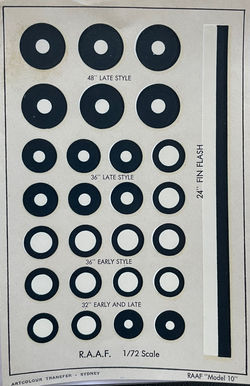WW2
AUSTRALIA RAAF 1/72-SCALE DECALS WING & FUSELAGE ROUNDEL EARLY & LATE
FIN FLASH
--------------------------------------------
Additional Information from Internet Encyclopedia
In the China/Burma/India (CBI)
theatre and Pacific it was thought that the red centres of RAF roundels could
be confused with the red hinomaru carried by Japanese aircraft. After an RAAF
No. 11 Squadron Catalina was mistaken for a Japanese aircraft by a US Navy
Wildcat in the Pacific Theatre[18] and attacked, the roundels on RAAF were
modified, mostly in the field, by painting over the red with white. Often the
yellow outer rings of type A1 roundels were left intact. No British or American
built aircraft had factory painted SEAC style roundels; all aircraft had to be
repainted, and, in many cases re-camouflaged by Maintenance Units behind the
lines or by front line squadrons.
When Spitfire Mk VCs reached the
CBI Theatre in November 1943 their type B, C and C1 roundels were all modified
by painting out the red centre spots in white, the red of the fin flash was
similarly painted over. When the Mk VIIIs arrived in early 1944 most of them
had their roundels overpainted completely and replaced by 16 inches (41 cm)
diameter SEAC roundels with light blue centre spots (a mix of dull roundel blue
and white) of approximately 7 inches (18 cm) diameter. The fin flashes were
replaced by 24 inches (61 cm) high by 16 inches (41 cm) wide versions, each
light blue (leading edge) and roundel blue stripe being 8 inches (20 cm) wide.
Mk VC Spitfires used by the
Royal Australian Air Force over Northern Australia in October 1943 had their
36-inch type C1 fuselage roundels modified to 32 inches (81 cm) SEAC roundels
by painting out the yellow outer ring in the camouflage colours and
over-painting the red centre in white. The lower wing type C roundels and upper
wing type Bs were also modified by over-painting the red centres in white. The
red fin stripe was also painted out with white and, in many cases the blue was
extended forward 1 in (25 mm) making equal widths of 12 inches (30 cm). RAAF Mk
VIIIs had their roundels and fin flashes modified in the same ways, although
some had their 55 inches (140 cm) upper wing roundels overpainted and replaced
with 32 inches (81 cm) SEAC roundels.
----------------------------------------------------
The beginning of the Pacific War—and the rapid advance of
Japanese forces—threatened the Australian mainland for the first time in its
history. The RAAF was quite unprepared for the emergency, and initially had
negligible forces available for service in the Pacific. In 1941 and early 1942,
many RAAF airmen, including Nos. 1, 8, 21 and 453 Squadrons, saw action with
the RAF Far East Command in the Malayan, Singapore and Dutch East Indies
campaigns. Equipped with aircraft such as the Brewster Buffalo, and Lockheed
Hudsons, the Australian squadrons suffered heavily against Japanese Zeros.
During the fighting for Rabaul in early 1942, No. 24
Squadron RAAF fought a brief, but ultimately futile defence as the Japanese
advanced south towards Australia.[19] The devastating air raids on Darwin on 19
February 1942 increased concerns about the direct threat facing Australia. In
response, some RAAF squadrons were transferred from the northern
hemisphere—although a substantial number remained there until the end of the
war. Shortages of fighter and ground attack planes led to the acquisition of
US-built Curtiss P-40 Kittyhawks and the rapid design and manufacture of the
first Australian fighter, the CAC Boomerang. RAAF Kittyhawks came to play a
crucial role in the New Guinea and Solomon Islands campaigns, especially in
operations like the Battle of Milne Bay. As a response to a possible Japanese
chemical warfare threat the RAAF imported hundreds of thousands of chemical
weapons into Australia.
In the Battle of the Bismarck Sea, imported Bristol
Beaufighters proved to be highly effective ground attack and maritime strike
aircraft. Beaufighters were later made locally by the DAP from 1944. Although
it was much bigger than Japanese fighters, the Beaufighter had the speed to
outrun them. The RAAF operated a number of Consolidated PBY Catalina as long
range bombers and scouts. The RAAF's heavy bomber force was predominantly made
up of 287 B-24 Liberators, equipping seven squadrons, which could bomb Japanese
targets as far away as Borneo and the Philippines from airfields in Australia
and New Guinea. By late 1945, the RAAF had received or ordered about 500 P-51
Mustangs, for fighter/ground attack purposes. The Commonwealth Aircraft
Corporation initially assembled US-made Mustangs, but later manufactured most
of those used.
By mid-1945, the RAAF's main operational formation in the
Pacific, the First Tactical Air Force (1st TAF), consisted of over 21,000
personnel, while the RAAF as a whole consisted of about 50 squadrons and 6,000
aircraft, of which over 3,000 were operational. The 1st TAF's final campaigns
were fought in support of Australian ground forces in Borneo, but had the war
continued some of its personnel and equipment would likely have been allocated
to the invasion of the Japanese mainland, along with some of the RAAF bomber
squadrons in Europe, which were to be grouped together with British and
Canadian squadrons as part of the proposed Tiger Force. However, the war was
brought to a sudden end by the US nuclear attacks on Japan. The RAAF's
casualties in the Pacific were around 2,000 killed, wounded or captured.
By the time the war ended, a
total of 216,900 men and women served in the RAAF, of whom 10,562 were killed
in action; a total of 76 squadrons were formed. With over 152,000 personnel
operating nearly 6,000 aircraft it was the world's fourth largest air force.





